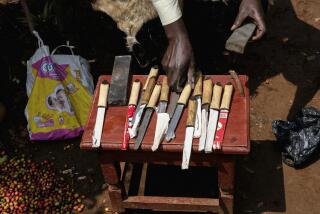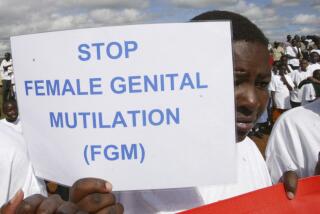HIV prevention done right
- Share via
This week, tens of thousands of delegates are meeting in Washington for the biennial International AIDS Conference, striving to advance an agenda for an AIDS-free generation. Achieving such an ambitious goal will require multiple strategies, but virtually all agree that male circumcision -- which provides powerful protection against HIV infection as well as other health benefits for men and women -- must be a core element. Yet although some prevention efforts in Africa have been successful, others have floundered.
One of the lessons learned from these experiences is that when powerful Western donors set out to help people in poorer parts of the world, they sometimes end up creating more problems. However, when done properly, with local communities and their leaders centrally engaged, international health initiatives can save millions of lives.
On July 5, PBS’ “NewsHour” included a GlobalPost report on “Why a U.S. Circumcision Push Failed in Swaziland.” Long-term follow-up research indicates this one-time procedure reduces HIV risk in heterosexual men by about 70%. As fewer men become infected, fewer women are exposed to the virus. Thus, if a recent program had been more effectively implemented, many thousands of new infections could have been prevented in Swaziland, which suffers from the world’s highest HIV rate.
In late 2005, while I was employed by the U.S. Agency for International Development as its regional HIV prevention advisor and based in that small kingdom, we began funding the Family Life Assn. of Swaziland, or FLAS, to develop a pilot initiative for safe and affordable circumcision services. This was before the HIV-prevention benefits of the procedure were fully proved, so our small grant supported circumcision as part of general male health services and not specifically as a weapon against AIDS. Studies in Africa show that men as well as women tend to view male circumcision favorably, primarily for reasons such as improved hygiene.
The program was immediately inundated with clients. There was nearly a “circumcision riot” when about 150 men came to a free circumcision event but many were turned away because there weren’t enough clinicians. During the one-year project, FLAS could barely keep up with the demand, even though knowledge of the program was spread mainly by word of mouth. Nonetheless, in late 2006 administrators of the U.S. government’s global AIDS program, PEPFAR, declined to renew its modest ($150,000 a year) funding, ruling that it conflicted with U.S. policy, which would not support circumcision until its HIV-prevention effect was definitively proven.
The following year, after several clinical trials in Africa confirmed the effectiveness of circumcision, PEPFAR decided to undertake an ambitiously rapid scale-up in one nation in southern Africa, the world’s most hard-hit region. It eventually chose Swaziland, presumably in part because it had substantial experience with a circumcision program. Those of us involved in the original FLAS initiative there recognized that it was imperative, in reality and in public perception, for the Swazis to be in the driver’s seat of such a potentially crucial initiative.
But the new project went in a very different direction, as pointed out in the GlobalPost report. The level of funding and foreign consultant presence grew dramatically. Although well meaning, this created the impression of a rashly developed U.S. initiative to persuade 80% of Swazi males to become circumcised within a year. The angry emails I received from friends and colleagues in Swaziland were consistent with what GlobalPost found: “Ask Swazi AIDS professionals about the campaign and many will privately -- for fear of jeopardizing future U.S. funding -- term it a ‘disaster,’ a ‘nightmare’ and ‘an exercise in bullying.’ ”
Mahlubi Hadebe, prevention coordinator of Swaziland’s national HIV/AIDS program, was quoted as saying, “[The American contractors] just would not listen....You have to identify thought leaders in communities and use them to convey the message.” He and others also believed that some of the billboard and other messaging was poorly conceived: “ Lisoka lisoka ngekusoka -- which literally means ‘the lover boy is a lover boy thanks to circumcision’ -- appeals to the playboy in the man.” (In contrast, a 2006 FLAS poster read, “I’m circumcised and I’m proud.... And I’m still faithful to my partner,” and we secured a waiver to avoid including the standard USAID logo “From the American people.”) The head of Swaziland’s HIV/AIDS program, Derek von Wissell, told me recently, “The campaign was well-intended but ... we were hardly involved.... It was a very regrettable use of resources.”
Fortunately, there are better models in Africa. For years, foreign researchers, such as Robert Bailey of the University of Illinois at Chicago, have collaborated with Kenyans to study why HIV rates were so much higher in Nyanza province, the only part of the country where most men weren’t traditionally circumcised. They worked closely with Kenyan counterparts to establish a vigorous national program. Over the last three years, there have been about 400,000 circumcisions in Nyanza, boosting the proportion of men circumcised from 17% in 2007 to about 60% now.
In the neighboring East African country of Tanzania, more than 100,000 circumcisions have been performed in less than two years. And though progress continues to be disappointing in much of southern Africa, there are some promising initiatives, in Zimbabwe and Lesotho, for example. It is estimated that by 2025 about 300,000 HIV infections (about half of those in women), as well as many cases of cervical cancer and other sexually transmitted diseases, will have been averted by these and other new circumcision programs in Africa, and millions more in the decades thereafter.
As Bailey emphasized in an email this month from Kenya: “So much of success is about local ownership and branding. Here, Voluntary Medical Male Circumcision is a Kenyan program, owned and run by the Kenyan government ... but what I’ve seen in other countries is that the program is run by American contractors. They slap their logo all over everything ... and present the program as theirs.”
In addition to local ownership, some experts have observed something else that’s crucial: Programs are likely to be more effective if they are presented to local communities as part of integrated health services rather than being overly linked to AIDS. But as Bailey also noted, “It’s hard to turn the supertanker around” after the emphasis in recent years has been, understandably, so focused on the HIV prevention potential of this ancient and recently revived medical practice.
More to Read
Sign up for Essential California
The most important California stories and recommendations in your inbox every morning.
You may occasionally receive promotional content from the Los Angeles Times.













